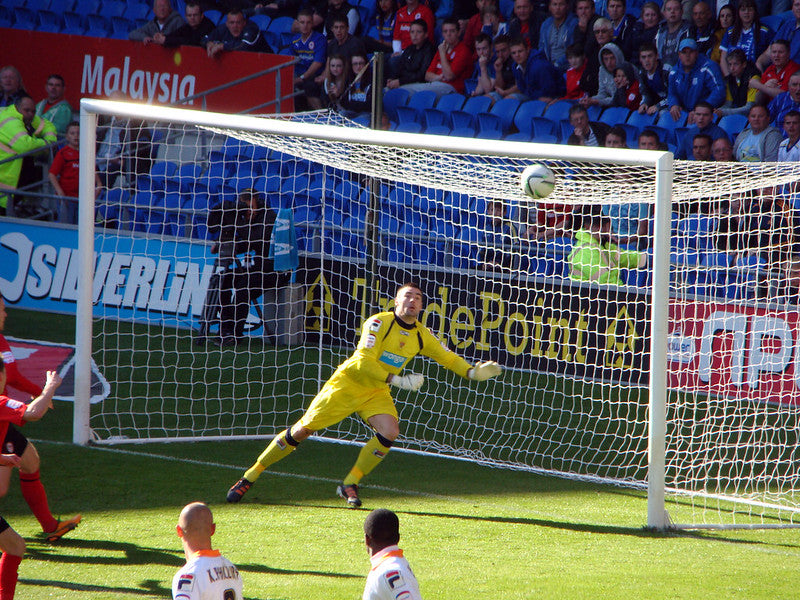It may come as a surprise to some to learn that soccer goals can vary in size and dimensions and that different soccer organizations have their requirements when it comes to the goals used within their private leagues and age groups. Generally, goals used for youth or indoor soccer are not the same size as a standard soccer goal but are narrower and less tall. The goals found in youth soccer are generally between 16.5 and 21 feet wide and between 6.5- and 7-feet tools, while those in indoor football are 12 feet wide and 6 feet 6 inches tall.
Here are the Soccer Goal Sizes used by various governing bodies.
FIFA Regulation Size Soccer Goal
According to FIFA (Fédération Internationale de Football Association), a soccer goal consists of two upright posts that are joined together horizontally by a crossbar, and are situated equidistant from the corner flags on each side of the pitch. The crossbar and goalposts must be made from wood, metal, or other approved material, and the posts, furthermore, must be either round, rectangular, square or elliptical, and should pose no risk or physical harm to players. The crossbar and goalposts must be white – no other color is permitted.
The posts should be 8 yards apart, while the edge of the crossbar, at its lowest, should measure 8 feet from the ground. Both the goalposts and crossbar should have a uniform width and depth, which must not be greater than 5 inches (12 centimeters). Goal nets can be attached, but they are required to drape on the ground behind the goal, and should not impede or interfere with the actions of a goalkeeper in any way.
NCAA Size Soccer Goal (National Collegiate Athletic Association)
The requirements for US colleges are close to those set by FIFA.
The goal consists of two posts and a crossbar that should be made of the same or similar material. The lower edge of the crossbar should sit 8 feet from the ground, while, at a minimum, the distance from the corner flags to the outside of each post must be a minimum of eight yards on either side. The posts and the crossbar must be painted white and can be square, round, rectangular, or elliptical. They should be between 4 and 5 inches (10.16 and 12.7 centimeters) in both width and diameter.
Furthermore, the regulations do not allow for any more than one marking – logo or another form of identification – of a single manufacturer to appear on posts or crossbars at any point.
High Schools Size Soccer Goal (NFHS)
The NFHS stipulates that, for high school soccer, a goal should consist of two upright posts that must be placed along a goal line and are between 4 and 5 inches in diameter. They are joined by a horizontal crossbar that must be equal in dimensions. The rear of each goal post must be situated on the outer edge of a goal post, while the goalposts and corner flags should be 8 yards apart. As with a FIFA-approved goal, the lower side of the crossbar should be 8 feet off the ground.
They also state that a soccer goal must be painted white, and the only other marking allowed is a single identification or logo of a manufacturer which may appear either on the crossbar or on the goalposts.
- Beach Soccer
Beach soccer goals are slightly smaller than full-size turf equivalents. They are 18 feet wide and 7.25 feet high and are intended to make it a bit easier for the keeper to cover the goalmouth, despite the challenges of having to make diving saves on loose sand.
- Futsal
Indoor football, or Futsal, has its requirements when it comes to goal sizes and dimensions. They should be 9 feet 10 inches wide (3 meters), 6 feet 7 inches high (2 meters), and should have depth behind the goal of 3 feet 7 inches (1 meter).
- US Youth Soccer
Different requirements are depending on the age of the child itself. These are as follows:
Ages 12 and over: The goal’s dimensions should be 8 ft by 24 ft. The Open Goal® Regulation, Large, or Standard is the recommended backyard soccer goal for this age range.
Under 12 years down to 8 years old: The goal should measure 6 ft by 18 ft, at a minimum, or 7 ft by 21 ft as a maximum.
The Open Goal® Regulation, Large, or Standard is the recommended backyard soccer goal for this age range.
Children 6 to 7 years old: The minimum dimensions of a goal for this age group are 5 ft by 9 ft, while the maximum allowed is 6 ft by 12 ft.
The Open Goal® Standard or Junior is the recommended soccer goal for this age range.
Children 4 to 5 years old: For children of this age, the minimum size allowed is 4 ft by 6 ft, and the maximum is 5 ft by 10 ft.
The Open Goal® Junior is the recommended soccer goal for this age range.
Children 2 to 3 years old: The youngest category of player should use a goal that ranges from 3 to feet at a minimum, through to 4 by 6 feet at the maximum.
It should be noted, however, that for young players, it is not a requirement that goals are of an exact size. What is more important is that they are an appropriate size for them and that they are safe. They should also be the best size for them to learn critical skills and to maximize their enjoyment of the game.
Hero Image Source Here : Photo By John Candy

